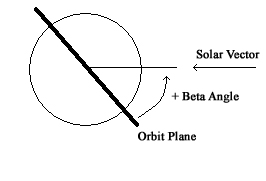Beta angle
Beta angle is a significant parameter in the field of orbital mechanics and satellite communication, which pertains to the orientation of an orbit relative to the Sun. It is particularly crucial for understanding the solar illumination conditions of satellites, especially those in Earth orbit, and plays a vital role in the planning of space missions.
Definition[edit | edit source]
The beta angle is defined as the angle between the Sun's rays and the orbital plane of a satellite. It is measured in degrees. A beta angle of 0° means that the Sun is in the plane of the satellite's orbit, leading to continuous sunlight for parts of the orbit. Conversely, a beta angle of 90° indicates that the Sun is perpendicular to the orbit, which can result in alternating periods of sunlight and darkness for the satellite.
Importance[edit | edit source]
The beta angle is critical for several reasons:
- Thermal Control: It helps in predicting the thermal conditions a satellite will experience in orbit. Satellites are designed with specific thermal tolerances, and understanding the beta angle can help ensure that these tolerances are not exceeded.
- Power Generation: For satellites with solar panels, the beta angle affects the amount of sunlight available for power generation. This is crucial for maintaining the satellite's operations and ensuring that its batteries are adequately charged.
- Mission Planning: The beta angle is used in mission planning to determine the best launch windows and orientations for satellites to optimize their operational lifespan and efficiency.
Calculation[edit | edit source]
The beta angle can be calculated using the formula: \[ \beta = \arcsin \left( \cos(\epsilon) \cdot \sin(\lambda) \right) \] where:
- \( \epsilon \) is the obliquity of the ecliptic, the angle between the Earth's equatorial plane and the ecliptic plane.
- \( \lambda \) is the satellite's orbital longitude relative to the vernal equinox.
Applications[edit | edit source]
- Sun-synchronous orbits: Satellites in these orbits are designed to keep a constant beta angle to ensure consistent lighting conditions, which is particularly useful for Earth observation satellites.
- Geostationary satellites: Understanding the beta angle is essential for managing the thermal environment of these satellites, as their position relative to the Sun changes throughout the year.
Challenges[edit | edit source]
Managing the effects of the beta angle poses several challenges, especially for satellites in low Earth orbit (LEO). During high beta angle conditions, satellites may experience thermal stress or power generation issues due to prolonged exposure to sunlight or extended periods in the Earth's shadow.
This article is a space- or spaceflight-related stub. You can help WikiMD by expanding it!
Beta angle gallery[edit | edit source]
Search WikiMD
Ad.Tired of being Overweight? Try W8MD's physician weight loss program.
Semaglutide (Ozempic / Wegovy and Tirzepatide (Mounjaro / Zepbound) available.
Advertise on WikiMD
|
WikiMD's Wellness Encyclopedia |
| Let Food Be Thy Medicine Medicine Thy Food - Hippocrates |
Translate this page: - East Asian
中文,
日本,
한국어,
South Asian
हिन्दी,
தமிழ்,
తెలుగు,
Urdu,
ಕನ್ನಡ,
Southeast Asian
Indonesian,
Vietnamese,
Thai,
မြန်မာဘာသာ,
বাংলা
European
español,
Deutsch,
français,
Greek,
português do Brasil,
polski,
română,
русский,
Nederlands,
norsk,
svenska,
suomi,
Italian
Middle Eastern & African
عربى,
Turkish,
Persian,
Hebrew,
Afrikaans,
isiZulu,
Kiswahili,
Other
Bulgarian,
Hungarian,
Czech,
Swedish,
മലയാളം,
मराठी,
ਪੰਜਾਬੀ,
ગુજરાતી,
Portuguese,
Ukrainian
Medical Disclaimer: WikiMD is not a substitute for professional medical advice. The information on WikiMD is provided as an information resource only, may be incorrect, outdated or misleading, and is not to be used or relied on for any diagnostic or treatment purposes. Please consult your health care provider before making any healthcare decisions or for guidance about a specific medical condition. WikiMD expressly disclaims responsibility, and shall have no liability, for any damages, loss, injury, or liability whatsoever suffered as a result of your reliance on the information contained in this site. By visiting this site you agree to the foregoing terms and conditions, which may from time to time be changed or supplemented by WikiMD. If you do not agree to the foregoing terms and conditions, you should not enter or use this site. See full disclaimer.
Credits:Most images are courtesy of Wikimedia commons, and templates, categories Wikipedia, licensed under CC BY SA or similar.
Contributors: Prab R. Tumpati, MD


